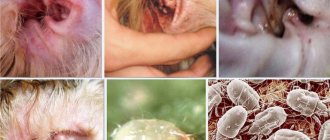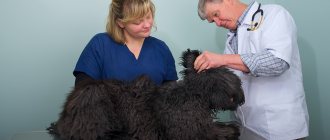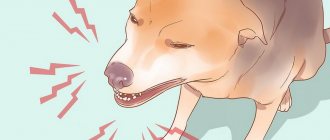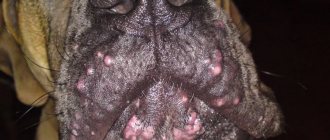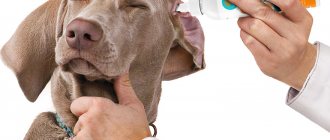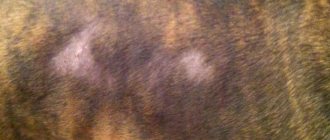There are quite a few reasons why a dog scratches its ears with its paws, and at the same time they are all different.
Most often, a dog scratches its ears when it has ear diseases.
The fact that your pet’s ears hurt is not difficult to notice by the behavior of your dog: he often begins to scratch his ears with his paws, shake his ears, and various kinds of discharge appear from his ears. Moreover, an unpleasant odor emanates from these secretions.
Ear disease is most common in those breeds of dogs that have long floppy ears - setters, dachshunds, Afghan hounds, spaniels, beagles, etc. And this is due to the fact that the ears of such dogs often lie on the floor and are poorly ventilated.
Causes of ear disease in dogs:
- Ear mites.
- Inflammation of the middle ear.
- Inflammation of the outer ear, including otitis externa.
- Allergic and skin diseases.
- Trauma in the ear area, incl. ear hematoma.
- Foreign bodies that enter the dog's ear during a walk (dry grass, plant seeds, etc.) initially lead to irritation of the delicate skin of the ear and the development of inflammation. As a result of bacteria, viruses, fungi and yeast entering the ear canal.
- Disease of the endocrine glands (hypothyroidism).
- Various types of hereditary and immune diseases, as well as cancer.
Description of the disease
Does your dog have itchy ears? Perhaps it is otodectosis or ear scabies. They belong to the group of parasitic (invasive) diseases. The causative agent is Otodectes cynotis (lat.) - a parasitic species of oribatid mites from the family Psoroptidae. It lives only in the auricle and inner ear of the animal, and is not found in other parts of the body. The tick gnaws passages in the epidermis (upper layers of skin), feeding on secretions of tissue fluid and lymph. The dog's ear becomes contaminated with serous discharge. If the disease progresses, purulent discharge begins. The inside of the ear becomes crusty, and there may be bald patches around the edges of the ear.
Animals aged from 2-3 weeks to 1 year are most often infected. Puppies become infected from their mother. Adults become infected from stray animals, during walks, and when interacting with other dogs. Cats most often suffer from otodectosis. Transmission of the pathogen can occur through grass, dirty shoes and other objects with which the pet comes into contact. If measures are not taken, then ear scabies in a dog can cause complications in the form of otitis media, meningitis, followed by inflammation of the meninges. In this case, it will be extremely difficult to treat the dog.
How to identify the cause of anxiety
The first thing to do is to examine the ear for the presence of a foreign body. It is important to clean the ear of discharge and possible pus. With otitis media of a bacterial nature, the ear squishes. Parasitic otitis media is characterized by black discharge. It is important to take a sample for analysis. The scraping can reveal parasites (mites) under a microscope. A smear is also taken for bacterial culture, which is sent to the laboratory. There, a colony of the pathogen is grown on a special medium, differentiated, and tested for sensitivity to antibiotics. Lice, lice and various other parasites are detected visually.
Development of the disease
Serous discharge begins in the auricle. Use the corners of furniture to scratch your head. Subsequently, the serous discharge will be replaced by purulent discharge. An unpleasant putrid smell appears from the ears. A crust forms on the inside of the ear, in the pinna. The dog whines, shakes its head, unable to find peace. Her hearing is significantly deteriorating. Complications begin in the later stages:
- Otitis – inflammation of the external auditory canal; The dog has difficulty swallowing and may make circular movements towards the most affected ear.
- Labyrinthitis (inflammation of the inner ear) causes the animal to sit with the affected ear tilted downwards (bowheadedness).
At the last stage of the disease, inflammation of the lining of the brain begins. The dog may experience nervous attacks, convulsions, and shakes. This stage is almost always fatal.
Information for dog owners.
Otodectosis in dogs is extremely rare. Treatment of otodectosis in dogs is no different from that described for cats, using drugs as “Bars Forte ear drops for dogs” and “Aurizon” ear drops for dogs. We discussed the first drops in detail earlier. instructions, as well as the price of Aurizon ear drops, on specialized websites. With timely detection and treatment of otodectosis, the prognosis is favorable.
And in order for your pet to always be healthy and not suffer from ear diseases, do not forget about the basic preventive measures:
- ear hygiene,
- regular treatment of your pet with antiparasitic drugs,
- balanced nutrition and preventive examination.
Treatment
In the early stages of ear scabies, you can do the procedures yourself, with the help of family members. Place the dog on its side, calm it down, and fix its head. Using cotton swabs soaked (optional) in hydrogen peroxide, in solutions of furatsilin (1:10,000), boric acid (3%), rivanol (0.1%), moisten the affected surfaces of the ear. Wait a few minutes for the crust to soften and remove it. If treatment is carried out with the drug Otoferonol, then you can moisten the tampon with the same product.
It is necessary to clean the auricle of purulent and serous discharge, remove the crust, and thoroughly clean the ear. This is an indispensable condition, without which subsequent treatment will be ineffective. Uncleaned dirt in the ear will not give the medicine access to the mites that are located under the epidermis of the skin. A new tampon is used each time for one action. This will prevent infection from spreading to healthy areas of the ears. Then you need to drop the required amount of medicine into your ear. It is advisable to keep the dog for a while in a motionless state, in which the treatment was carried out. After instillation, the dog shakes its body, the medicine flies out and the effectiveness of the treatment decreases. If possible, massage gently behind the ears with the pads of your fingers.
It doesn’t matter whether the dog’s second ear hurts or not, both are subject to the procedure.
Treatment must be repeated after 10 days. Otherwise, the remaining tick eggs will develop into adults and the disease will resume. In advanced stages, treatment is carried out by specialists. In case of complications (otitis media and labyrinthitis), surgery cannot be ruled out.
Ear diseases that cause itching - symptoms
In most cases, if a dog scratches its ear and periodically whines, this indicates the development of an inflammatory process caused by diseases. Each of them is characterized by certain symptoms that you need to pay attention to.
Otitis
The disease develops as a result of microorganisms entering the animal’s auditory organ. Experts distinguish 3 types of otitis: external, middle and internal. Pets are more susceptible to it, often suffering from allergies, in which hair is present in the ear canals, and the body is covered with folds.
With otitis externa, inflammation occurs in the visible part of the ear. Infected lesions are also possible. In the middle type of the disease, a part of the auditory organ that is invisible to the naked eye is affected. In this case, the dog actively scratches its ears until it hurts. There is also abundant clear discharge, and a gurgling sound is heard when massaging the ear.
Otitis media is the most common disease in dogs.
With internal otitis, the pet feels severe, sharp pain. It becomes difficult for him to turn his head, so he turns his whole body. At the same time, the animal’s general health deteriorates, it loses its appetite, its nose becomes hot and dry.
Allergy
Ear irritation in a puppy or dog can be caused by a reaction of the endocrine system to an allergen. It can be triggered by new food, medicine, or pollen. With allergies, not only do your pet's ears become red and thick, but their eyes also become watery and there may be copious nasal discharge.
Foreign body
Another reason why a dog's ears constantly itch may be a foreign body that has entered the ear canal and caused irritation. Most often this comes from a plant seed, a small lump of earth, or an insect. When a foreign body enters, symptoms occur suddenly. The dog begins to shake its head, shows concern, and tries to get its paw into its ear.
Otodectosis
The ear organ can itch as a result of the development of the disease otodectosis, caused by the ear mite Otodectes. The parasite has a microscopic size, which makes diagnosis difficult at the initial stage of the lesion. The mite reproduces in the ear canal, since there are all the necessary conditions for this - moisture and warmth. It feeds on dog blood, lymph, skin particles, and sulfur.
Important! Otodectosis is a contagious disease, and is quickly transmitted from a sick dog to a healthy one upon contact.
When a nursing dog is infected with an ear mite, the parasitic infection spreads to the puppies, which can cause their death.
The main symptoms of otodectosis:
- head shaking;
- severe itching in your pet's ears;
- scratching on the face and back of the head;
- brown plaque in the ears.
As a result of the activity of mites, crusts form in the dog’s ear canal, which over time begin to smell unpleasant and emit a putrid odor. The dog may also scratch areas near the ears in an attempt to reduce discomfort. As a result, bald spots appear in these places.
Lack of adequate treatment can lead to blockage of the canals, rupture of the eardrum, and a sharp increase in body temperature to a critical level. Subsequently, the inflammatory process spreads to the middle ear and can switch to the meninges, which is extremely dangerous.
Otodectosis affects both ears
Drugs and medicines
Treating your pet nowadays is not difficult if you recognize the infection in time and do regular care. Pet owners have at their disposal a wide selection of treatments for their pets. All drugs for the treatment of ear mites can be divided into categories:
- Ointments and gels.
- Ear drops.
- Drops in pipettes and emulsion concentrates.
- Sprays.
- Injections.
- Drops on the withers.
It is most effective to treat a sick animal with drops in the ear. They have a direct effect on the causative agent of the disease - the tick. Drops “Otovedin”, “Anandin-plus”, “Otoferonol-Gold”, “Otoferonol-Premium” are complex preparations. In addition to the direct acaricidal effect (they kill the tick), they have an anti-inflammatory effect.
You can give your pet injections based on ivermectin if there is a need for a complex effect on the dog’s body. Invermectin suppresses the development of helminthiasis (worms) in almost all parts of the animal’s body. It is also effective against skin diseases: scabies, dermatoses, fleas and lice.
If everything is fine with the dog’s ears, you can still sometimes use drops on the withers. The most common and effective are “Advocate”, “Frontline”, “Stronghall”. Applying drops to the withers will help avoid infections during walks.
Invermectin-based injections cannot be used on collie dogs and their subspecies: bobtails, border collies, shelties, etc. These breeds have an intolerance to these drugs and their use can lead to the death of the dog. Why is this happening? During the selection process, a gene (MDR1) mutated in Scottish sheepdogs and their subspecies, which caused increased sensitivity of these breeds to opioids, some antibiotics, ivermectin and steroids. Invermectin is also not recommended for pregnant or lactating female dogs of all breeds.
Foreign body
A dog is not a child and cannot put a foreign object in its ear. But it is not uncommon for grass or tenacious plant seeds, burdock or an insect to accidentally get into the ear. The foreign body causes discomfort to the dog - the dog persistently rubs its ear with its paws and whines. It is necessary to examine the ear yourself as quickly as possible or take your pet to a veterinarian. If a foreign body remains in the ear for a long time, serious inflammation may develop, which will require long-term treatment.
Prevention of ear mite diseases
Prevention of otodectosis is simple and is part of the normal daily care of your pet. Following a few simple rules allows you to prevent the appearance and development of this painful disease.
- After each walk, during evening procedures, wipe the inner surfaces of your ears with clean swabs or napkins. You can moisten them with gentle disinfectant solutions. For example, hydrogen peroxide.
- Try to prevent your dog from coming into contact with stray animals, especially cats.
- Regularly disinfect your pet's living area. If your dog has an enclosure, treat it with acaricidal sprays, in addition to regular cleaning.
- Constantly disinfect equipment: collars, leashes, muzzles, toys and exercise equipment.
Veterinarian advice
Ear diseases are extremely dangerous for dogs, as they can lead to hearing loss, one of the key sense organs of these animals. To avoid such problems, veterinarians advise undergoing preventive examinations at least 2 times a year, as well as timely treatment for parasites.
It is highly not recommended to self-medicate, since all otitis media have similar symptoms.
If you notice that your pet is scratching its ears or scratching its skin until it bleeds, seek help as soon as possible.
Diagnosis is important if the puppy scratches its ears and whines - at this age the risk of complications is higher.
When to contact a veterinarian
Scratching is not always a sign of illness. Normally, all dogs scratch their heads and try to get rid of wax on their own. Symptoms when you should contact a veterinary clinic:
- behavioral changes, restlessness and irritability;
- whining while scratching, when touching the ears;
- tilts and shakes his head to the side;
- the presence of a large amount of exudate, dirt in the ears;
- unpleasant odor;
- refusal to eat, poor sleep.
You should not delay visiting a doctor, as diseases can lead to complications and hearing loss.
Self-medication is dangerous, as qualified diagnostics are required to determine the cause of the problem.
Briefly about the main thing
- Due to their anatomy, the ears are susceptible to diseases. Common problems include otitis media, tick infestation, allergies, and foreign body ingestion.
- Ear diseases are accompanied by itching and tilting of the head to the side. There may be a decrease in appetite and problems with sleep.
- Treatment can only be prescribed by a doctor. To make you feel better, you need to massage your ears and clean the shells of secretions.
- Proper ear care is an important part of preventing diseases and infections. It is required to carry out systematic cleaning, hair removal and treatment for parasites. Visit your veterinarian twice a year for a checkup.
Have you ever experienced ear problems in your dog? Share in the comments how to relieve your pet’s anxiety and discomfort before visiting the clinic.
5 years ago my wife and I got a male Irish Terrier. This is a very energetic, social and intelligent dog. I love him for his honesty and the feeling of joy that he gives every day. I often consult with veterinarians and dog handlers. I believe that raising and maintaining a pet is a great responsibility, because it depends on the person in everything. I want the dog to feel comfortable and safe. I write articles about dogs to share my experience with other owners. We all face various problems in the process of keeping four-legged friends, and knowing the information, you can avoid mistakes and unpleasant consequences.
Source
